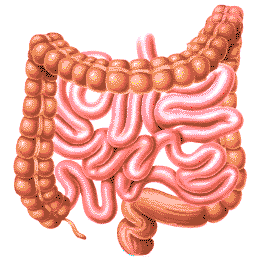

MedFriendly®


Intestine
The intestine is a tube shaped structure that is part of the
digestive tract. The intestine stretches from an opening in
the stomach to the anus and occupies most of the lower
parts of the belly. Food passes through the intestine and
digestion takes place. Digestion is a process in which
food is broken down and is absorbed (along with water)
into the bloodstream.
The intestine is divided into two main sections: the small
intestine and the large intestine. The small intestine takes
in all of the nutrients that the body needs. The large
intestine absorbs moisture from the matter that is left, and
Excrete means to release from the body as waste.
Small & Large Intestines
FEATURED BOOK: Natural Solutions for Digestive Health
Many people associate the colon with the intestines. The colon is the major part of the
large intestine. The top end of the colon is attached to the cecum, which is the first part
of the large intestine. The bottom end of the colon is attached to the rectum, which is the
last part of the large intestine. The intestines can be seen in the above picture.
Intestine is also known as the bowel, bowels, gut, and intestinum. Intestinal means
relating to the intestine. Intestine comes from the Latin word "intestinus" meaning "inner."
"Where Medical Information is Easy to Understand"™















